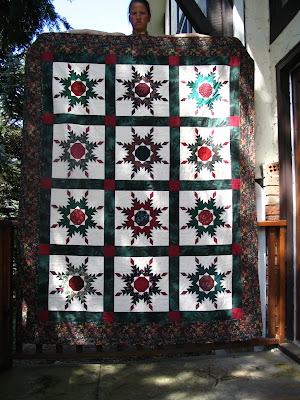"Art is restoration: the idea is to repair the damages that are inflicted in life, to make something that is fragmented - which is what fear and anxiety do to a person - into something whole."
Louise Bourgeois
I had this moment of recognition - oh these are the words to explain why I do what I do. Something to do with putting things back together, of making sense from what often feels random and chaotic. Making a whole from the broken bits.
Before I left the world of traditional quilt making, I took enormous pleasure in making quilts with corners that fit exactly and points that were perfect. In fact, it was being able to cut out pieces of fabric and sew them together again to make a whole where everything matched that got me into quilting in the first place. We were living in a basement suite in Vancouver at the time, our twin daughters were only months old, and my husband was going to university full-time, and moonlighting as a dishwasher at an extended care facility. I could barely remember which baby needed to be fed next, but knew I needed something to do outside baby care or I would circle down the drain. Learning how to make an Ohio Star block felt like some kind of magic in the midst of all this.
For years and years, I would come back to methodically piecing a quilt whenever my world felt as though it was tipping a little. In doing so, I was returning to something made sense to me - making a quilt block - even if I had no idea of how the rest of the pieces of my life were going to fit together.
Each of my children was given a traditionally pieced quilt upon graduation - well, maybe a little bit after graduation. Each leave-taking was a time of celebration but also a time of sadness. My world felt off kilter with each child's departure. It realigned itself in time - or healed, to put it another way - and the making of a quilt with exact piecing for each child helped me in the process.
In time I moved onto improvisational quilting. Corners and points no longer mattered in the same way, but a cohesive and balanced whole mattered enormously. I began by just tipping the blocks on an angle, and varying the size of the strips of each log cabin.
And then in the late 1990's, I took a workshop with Pat Crucil, and that changed everything. The freedom I discovered as I worked intuitively, rather than planning everything out beforehand, was intoxicating. I had been introduced to a new way of working that resonated deeply with me.
There were numbers of quilts made in this manner, "The Red Door" being one of the early ones. I discovered that I wasn't only putting the fabric together as I worked, but I was creating a new narrative in the process.My piece made for the FAN exhibit, Ekphrastic, pushed this even further.
And it can be seen in works like "Willows", made quite recently. In every instance, every new work, I am taking a number of disparate fragments - cyanotype prints, African indigo prints, strips of assorted fabrics and tiny windows in this case - and putting them together into a new whole. It's restoration work, exactly as Louise Beorgeois describes.









A wonderful story that expresses so much about you ad an artist.
ReplyDeleteThanks, Val. You will probably recognize some of the wording of this from when you took Lisa Call's class yourself. It does seem to help make things clearer, about why we do what we do, with such single-mindedness and passion.
ReplyDelete